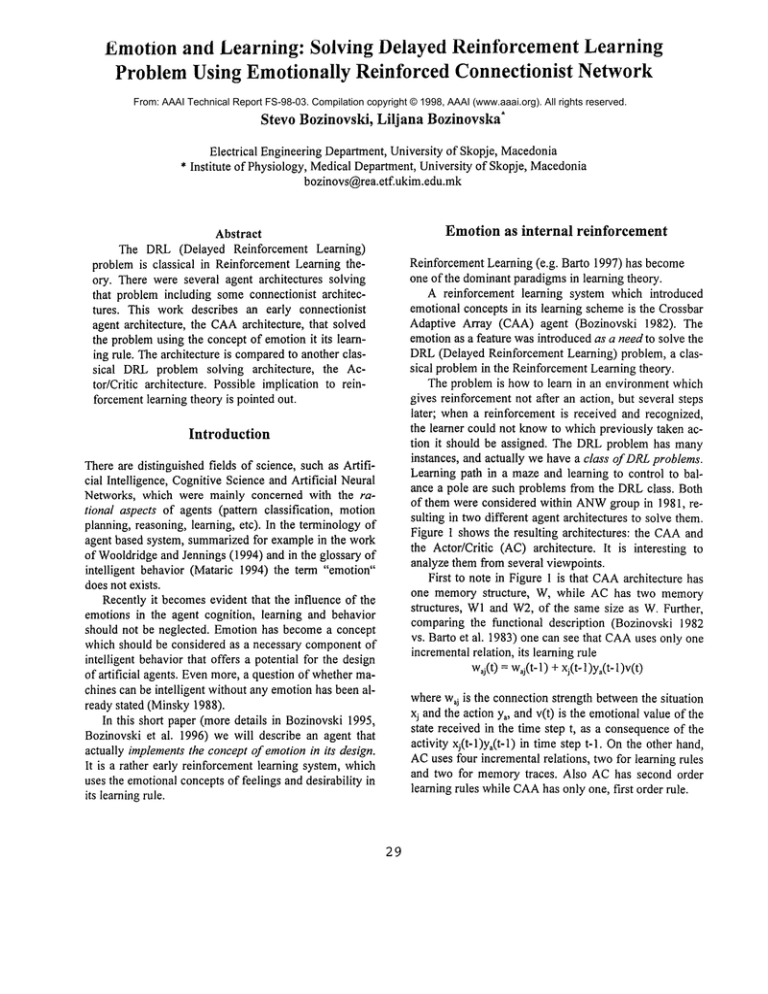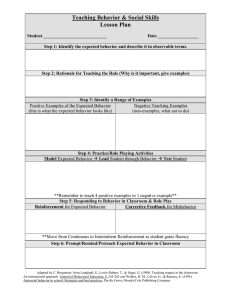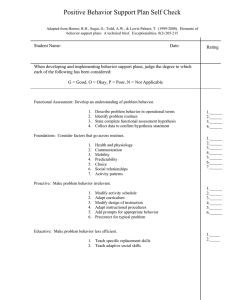
Emotion and Learning: Solving Delayed Reinforcement Learning
Problem Using Emotionally Reinforced Connectionist Network
From: AAAI Technical Report FS-98-03. Compilation copyright © 1998, AAAI (www.aaai.org). All rights reserved.
Stevo Bozinovski,
Liljana
Bozinovska"
Electrical Engineering Department, University of Skopje, Macedonia
* Institute of Physiology, Medical Department,University of Skopje, Macedonia
bozinovs@rea.etf.ukim.edu.mk
Emotion as internal
Abstract
The DRL(Delayed Reinforcement Learning)
problem is classical in Reinforcement Learning theory. There were several agent architectures solving
that problem including someconnectionist architectures. This work describes an early connectionist
agent architecture, the CAAarchitecture, that solved
the problemusing the concept of emotionit its learning rule. The architecture is comparedto another classical DRLproblem solving architecture,
the Actor/Critic architecture. Possible implication to reinforcementlearning theory is pointed out.
reinforcement
Reinforcement Learning (e.g. Barto 1997) has become
one of the dominantparadigmsin learning theory.
A reinforcement learning system which introduced
emotional concepts in its learning schemeis the Crossbar
Adaptive Array (CAA) agent (Bozinovski 1982).
emotionas a feature was introduced as a need to solve the
DRL(Delayed Reinforcement Learning) problem, a classical problemin the ReinforcementLearning theory.
The problem is how to learn in an environment which
gives reinforcement not after an action, but several steps
later; when a reinforcement is received and recognized,
the learner could not knowto which previously taken action it should be assigned. The DRLproblem has many
instances, and actually we have a class of DRLproblems.
Learning path in a mazeand learning to control to balance a pole are such problems from the DRLclass. Both
of them were considered within ANW
group in 1981, resuiting in two different agent architectures to solve them.
Figure 1 shows the resulting architectures: the CAAand
the Actor/Critic (AC) architecture. It is interesting
analyze them fi-om several viewpoints.
First to note in Figure 1 is that CAA
architecture has
one memory structure,
W, while AC has two memory
structures, W1and W2, of the same size as W. Further,
comparing the functional description (Bozinovski 1982
vs. Barto et al. 1983) one can see that CAAuses only one
incrementalrelation, its learning rule
w~j(t)
= Waj(t-1)+ xj(t-1)ya(t-1)v(t
)
Introduction
There are distinguished fields of science, such as Artificial Intelligence, Cognitive Science and Artificial Neural
Networks, which were mainly concerned with the rational aspects of agents (pattern classification, motion
planning, reasoning, learning, etc). In the terminologyof
agent based system, summarizedfor example in the work
of Wooldridgeand Jennings (1994) and in the glossary
intelligent behavior (Mataric 1994) the term "emotion"
does not exists.
Recently it becomesevident that the influence of the
emotions in the agent cognition, learning and behavior
should not be neglected. Emotion has becomea concept
which should be considered as a necessary componentof
intelligent behavior that offers a potential for the design
of artificial agents. Evenmore, a question of whethermachines can be intelligent without any emotionhas been already stated (Minsky1988).
In this short paper (more details in Bozinovski1995,
Bozinovski et al. 1996) we will describe an agent that
actually implementsthe concept of emotion in its design.
It is a rather early reinforcement learning system, which
uses the emotionalconceptsof feelings and desirability in
its learningrule.
where wai is the connection strength betweenthe situation
xj and the action YR,and v(t) is the emotionalvalue of the
state received in the time step t, as a consequenceof the
activity xj(t-1)y,(t-1) in time step t-1. Onthe other hand,
ACuses four incremental relations, two for learning rules
and two for memorytraces. Also AChas second order
leamingrules while CAA
has only one, fin-st order rule.
29
ENVIRONMENT
I
W1
r(R,pl
Y
¢
w2 i
iA
Y
wIAt
V ~ I
v(X)
]
Figure1. a. Actor~Criticarchitecture
Figure1. b. CrossbarAdaptiveArrayarchitecture
(Barto et al., 1983)
(Bozinovski 1982)
Figure 1. A comparisonbetweenACand CAAarchitecture
- emotionallyreinforced learning agents, early representative being CAA
architecture
Besides the apparent architectural difference between
ACand CAA,for the emotion community the most important difference is the philosophy of computingthe internal reinforcement. The basic concept for computingthe
internal reinforcement in ACis reinforcement prediction,
A separate memorystructure, W1, computes the prediction, p, of an explicit external reinforcement, R, and supplies an internal reinforcement, r(R,p). In CAA
the basic
concept is emotion, desirability of being in a particular
environment situation. CAAdoes not use the concept extemal reinforcement; instead it uses the concept of genetic
vector, an artificial genomewhichcomesfrom the genetic
environment.That vector deffmes initial value W(0)of
which in turn defines emotional preference toward the
states of the environment.In W(0)an internal state is defreed which will produce an emotion if addressed by an
environmentsituation. If that internal state is addressed,a
primary reinforcer is defined inside CAA.After that, a
secondary reinforcement mechanismis taking place: the
computedstate value v(X) of the current state X is backpropagated to the state from which X is reached, and that
state is becominga newreinforcing state. The importance
of the concept of state evaluation used in CAAbecame
evident after the workof Watkins(1989).
References
Barto, A.; Sutton, R.; and Anderson, C. 1983. Neuronlike elements that can solve difficult learning control
problems. IEEE Trans. Systems, Man, and Cybernetics
13: 834-846.
Barto A. 1997. Reinforcement learning. In O. Omidvar and D. Elliot (Eds.) Neural Systemsfor Control. p.
29, AcademicPress
Bozinovski, S. 1982. A self-learning system using
secondary reinforcement. In R. Trappl, ed. Cybernetics
andSystems Research, pp. 397-402, North Holland.
Bozinovski, S. 1995. Consequence Driven Systems,
GocmarPress
Bozinovski, S., Stojanov G., Bozinovska, L. 1996
Emotion, embodiment, and consequence driven systems.
Proc AAAIFall Symposiumon Embodied Cognition and
Action, p. 12-17, AAAIPress
Mataric, M. 1994. Interaction and Intelligent behavior.
Ph.D. Thesis, MIT.
Minsky, M. 1988. The Society of Mind, Simon and
Shuster
Watkins, C. 1989. Learning from delayed rewards. Ph.
D. Thesis, Kings College, Cambridge,England.
Wooldridge, M., and Jennings, N. 1994. Agent theories, architectures,
and languages: A survey. In M.
Wooldridge, and N. Jennings, Eds. Intelligent Agents,
Proc. ECAI-94Workshop, 1-39, Amsterdam, Holland
Implications to ReinforcementLearning
There are several taxonomies of reinforcement learning
systems. The CAAarchitecture suggests a dichotomial
taxonomyby which RLagents can be divided into two
classes:
- external reinforcementlearning agents, early representative being ACarchitecture
3O









